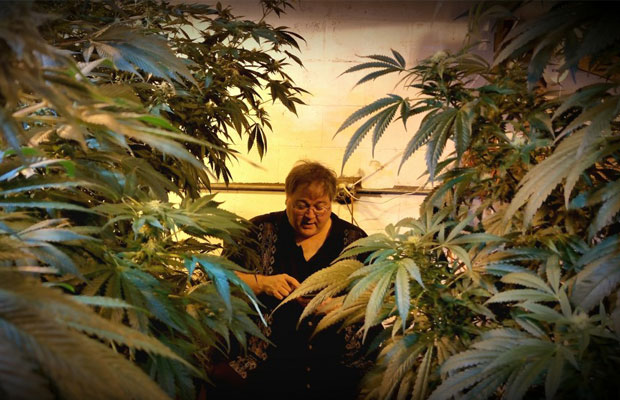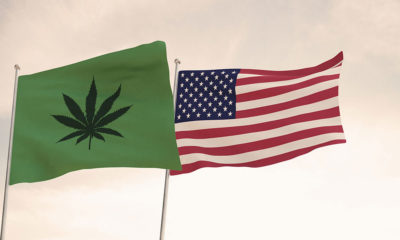
Legal
Paul Stanford: 40-Year Cannabis Activist Reflects on Legalization
Paul Stanford first tried cannabis when he was just 11-years-old. The year was 1971 and he was in his babysitter’s basement in Dallas, Texas. The offending “pusher” was the babysitter’s son, a 26-year-old who had just returned home from serving in the Vietnam War. Stanford didn’t start using cannabis regularly until he was 13 and able to scrape together $110 to buy his first pound. His intent at the time was to make a little extra money while stocking his own stash. He lost money on that first buy but a budding infatuation for the cannabis plant was sparked inside him. At 17 he moved to North Carolina and began selling cannabis and turning a profit.
Today, Stanford runs one of the nation’s largest and longest-running cannabis recommendation clinics, The Hemp and Cannabis Foundation (THCF aka Empower Clinics), which has registered over a quarter-million patients in 12 states since 1999. After changes in various state and local laws, THCF Clinics now operate in California, Colorado, Washington, Oregon and Michigan. For the last 20 years, Stanford has hosted a popular cable access show in Portland, Oregon: Cannabis Common Sense. He boasts a long history of activism; he has politically influenced or participated in the proposition and passage of dozens of pro-cannabis initiatives in various western states. Now, in the era of legalization Stanford reflects on the changes he helped create and what he would like to see going forward.
“People should be able to grow their own. I think it should be more like the wine industry than the tobacco or distilled alcohol industry,” Stanford says.
He says he was glad he wasn’t asked to comment about the most recent legalization initiative in Ohio, Issue 3, which was opposed by sectors of the pro-cannabis movement in the state who said it would create a cartel of wealthy investors controlling the entire market.
This wasn’t the first time pro-cannabis voters opposed a legalization initiative. In 2010 Proposition 19 would have made California the first state to vote to legalize recreational marijuana. Debates around the wording and regulatory structure led to segmentation of the movement and industry into various factions, resulting in voters who were otherwise pro-cannabis voting against legalization. It failed by just 3.5 percent.
A rift in ideology — pragmatism versus idealism — has led to division among pro-cannabis voters when it comes to the language that winds up on the ballot. Some point to the results of the most recent election in Washington as evidence that not all legalization is good legalization — the devil is in the details.
The effects and implications of the Washington rollout of legalization is close to home for Stanford, who was once the state’s NORML director and now lives just miles south of the border in Portland, Oregon.
In 2012 Washington State voters approved Initiative 502 (I-502) just hours after Colorado voters approved Amendment 64, making the two states the first to legalize for adult use, but the implementation of the two laws couldn’t have been more different.
In Washington, I-502 was hotly contested and opposed by much of the medical cannabis community. Growers and business owners who had been operating under the state’s medical cannabis law for years said the law would destroy a system that was generally working for them. The election was a turning point for reform advocates. Up until that point everyone had agreed on legalization, but it seemed there was no real consensus on the best way to do it. Legalization initiatives today are viewed under a stronger lens by advocates around the country, some saying they will support any incremental form of legalization no matter what, and others who say there are lines in the sand that cant be crossed.
“If I was an Ohio resident, I would have voted against it [Issue 3]. I couldn’t have supported it publicly the way it was written,” Stanford says.
Stanford wrote Measure 80, the Oregon Cannabis Tax Act of 2012, which would have created a regulatory body to enact legalization. The measure failed to pass, earning 47 percent of the vote.
“Basically it said people could grow for personal use without any real limit on plants or quantity. It said all applicants could grow cannabis and the purchase of it would be split among all applicants. It was decentralized to the extreme. Some people think not having a limit on the amount of personal cultivation is what made us lose.
“The other factor was that we set up an Oregon Cannabis Commission. Initially, we would have had the governor appoint them all like [she] does for most of the other state commissions. A couple people came to me and said, ‘you can’t let the governor set this up, you gotta position the new cannabis panel to be in our favor.’
“I changed it at the very last minute from being seven people appointed by the governor to being four people—a doctor, grower, retailer and processor—so the composition of the panel would be pro-cannabis. That was used against us; the local media said it was akin to putting Philip Morris in charge of tobacco [laws.] That was probably the thing that hurt us the most.”
In 2014, Oregon voters approved Measure 91, which Stanford did not run but supported, making Oregon the third state to legalize recreational cannabis. The law went into effect in July 2015 and recreational sales began October 1. Oregon dispensaries sold more than $11 million of cannabis in the first week of sales, easily doubling the revenues from Colorado ($5 million) and quintupling revenues from Washington State ($2 million).
Stanford says there is still more work to be done in Oregon, and as he has watched legalization unfold in Washington he advocates for less regulation.
“I supported I-502 with reservations. I thought it would move the ball forward, and it has, but there were a lot of problems with it and it was very contentious. All the naysayers were right, it did curtail medical marijuana and do the things that they were afraid of. So far it doesn’t look pretty at all up there,” he says.
Washington state’s legalization law has been critiqued for the high tax rate, among other things, which has made cannabis on shelves far more expensive than across the border in Oregon, where cannabis prices are the cheapest in the nation. High recreational prices combined with crippling restrictions for the state’s medical industry has proliferated a black market.
“I think there needs to be less [regulation in Oregon] and eventually there will be,” he says.
Stanford has an idea of where he would like to see change in regulation, influenced by witnessing and contributing to the last 35 years of legislative reform as the issue of legalized cannabis evolved from its countercultural roots to a mainstream movement and now the fastest-growing industry in the nation.
Shortly after he started selling cannabis as a teenager, Stanford began reading magazine articles and learned about a smoke-in In Washington D.C. shortly after his 18th birthday in 1978. He packed up his bags and went to tour the capitol. He says it was the first time he was exposed to the political side of his cannabis use and it changed his relationship with it. In 1981 he moved to Washington State and attended Evergreen State College. Before he left he grabbed a book at the library: countercultural icon Abbie Hoffman’s autobiography “Soon To Be A Motion Picture.”
Hoffman was a founding member of the Yippies, a political movement born of the 1960s counterculture and anti-war movements in New York City. Yippies, or the Youth International Party, were known for employing grand public political stunts to further their activist agendas. Marijuana was key to their political platform, and appeared prominently at the center of their flag. Beat poet Allen Ginsberg is also considered a founding member. Many former Yippies, such as Paul Stanford, are leaders in or have shaped today’s cannabis industry and political movement. Although there was never any hierarchy or structure to the organization, many well-known figures in the cannabis movement and industry have or still identify as Yippies: Ed Rosenthal, Steve D’Angelo, Ben Masel, Dana Beal and Tom Forcade, to name a few.
When Stanford came across Abbie Hoffman’s autobiography, Hoffman had been busted for cocaine and was “on the lamb.” The book was published while he was in hiding and on the very last page was a message to send a letter to Dana Beal at 9 Bleeker Street in Manhattan if the reader was interested in being part of the new movement. Stanford sent the letter and started receiving copies of the Yippie publication, Overthrow Magazine, which he sold at Evergreen State. A new Yippie activist was born.
While still a student, he became the Washington State director of the National Organization for the Reform of Marijuana Laws (NORML). Soon after he was introduced to and became friends with Jack Herer, author of “The Emperor Wears No Clothes,” a historical guide to hemp, its many uses and political history. Herer was a New York native who had settled in Oregon and spent his life campaigning for the full legalization of cannabis and all its uses, particularly industrial hemp. Herer passed away in 2010 and his influence and name are still used in and inspire legalization initiatives in California and elsewhere. Many popular strains either bear his name or are derivatives of the strain named in his honor, Jack Herer. In 1985 Stanford would contribute to the research of Herer’s book and hosted Herer in his living room while he compiled the first edition.
Stanford owned several hemp businesses after studying in China in the late ’80s. He made sold hemp paper and other hemp products imported from China, where hemp cultivation is both legal and thriving.
In August 1984, Stanford moved to Oregon to help campaign for the Oregon Marijuana Initiative alongside Herer and others. This was the second time a legalization initiative was put to American voters. In 1972 voters rejected the California Marijuana Initiative (also Proposition 19) by a margin of 66.5 to 33.5 percent.
The Oregon Marijuana Initiative failed to make the ballot in a contested dispute between the petitioners and the state’s attorney general. When the group sought signatures to qualify for the next general election in 1986, they were able to qualify over a year early. The initiative lost overwhelmingly with just 26 percent of voters supporting the measure, but only after heavy campaigning by the Reagan Administration. Nancy Reagan and then-vice president George H.W. Bush toured the state multiple times to campaign against it.
“It was really overkill,” Stanford says.
In July 1986, just months before the election, Stanford’s Portland home was raided and he was arrested for growing 13 cannabis plants in his basement. He served six months in prison. Stanford was released and immediately went to work drafting a regulatory bill in hopes of qualifying for the 1990 ballot. The measure didn’t pass.
In 1991 Stanford’s door was again kicked in and his home raided. This time his wife and 7-month-old son were present. Stanford’s arrest was characterized as political, his personal home collection of activist and cultivation how-to guides, books and magazines were introduced as evidence against him in a court. One book featured a chapter on jury nullification, which describes how juries can acquit a defendant of charges even if they find them guilty, simply because they do not agree with the law.
Activists with the Fully Informed Jury Association (FIJA) waited outside the courtroom doors and handed out informational flyers. Because the prosecution was already using Stanford’s home collection of cultivation and political books as evidence against him, his defense team turned the tables and asked Stanford to read aloud passages of Richard Jay Moeller’s “Marijuana and Your Legal Rights.” In the book was a chapter about jury nullification, which Stanford happily read aloud for the jury. He was found not guilty of the felony charges against him and instead guilty of simple possession — for the 2 grams he had in his shirt pocket the day he was arrested. Stanford credits FIJA for saving him from a 10-year mandatory minimum. He says the arrests were political retaliation for his activist work.
In October 1996, one month before California voters would approve medical marijuana (Proposition 215), Stanford went live with local physician and friend Dr. Philip Leveque on local cable access with Cannabis Common Sense. Leveque was a respected physician who co-hosted the show alongside Stanford until he passed away earlier this year. In 1998 Oregon, Washington and Alaska voted to follow California’s lead and legalize medical cannabis. Shortly after the law went into place, patients began lining up outside the studio on Friday nights in hope of catching Dr. Leveque to sign their recommendations. At the time it was extremely difficult for new patients to find a qualifying doctor who would sign, making compliance with the new law impossible for some patients.
Out of necessity, Stanford opened the first clinic so patients had a better way of getting Dr. Leveque to sign recommendations. They outgrew their first Portland office and then began opening more across the state in response to patient demand. THCF, as it came to be known, eventually spread to nine states, but as some laws were modified or hindered by legislatures he was forced to close clinics in states like Montana and Hawaii.
Today Stanford grows for patients in his urban Portland garden and says he will continue to push for an easing of the new regulations in Oregon. Although its legal to possess, he says there is still more work to do to reintroduce the cannabis plant back into mainstream society. He sees industrial hemp education and reintroduction is his top priority for reform.
“[Cannabis] is the oldest, most productive crop and it’s been cultivated for over 12,000 years. To prohibit the oldest and most productive crop, to me, is evil. Until we allow farmers to cultivate hemp without regard to its THC content, but according to the most productive varieties for all its products, then I think we still have work to do.”
Do you consider yourself a cannabis activist? Tell us about your experiences in the comments below.
























